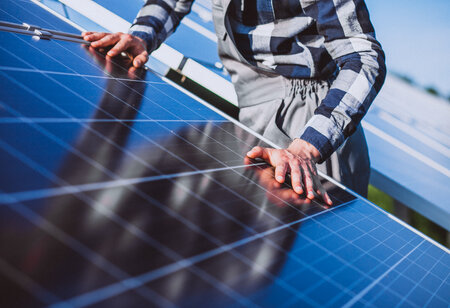
According to a survey by rating agency Icra, India's solar photovoltaic (PV) module production capacity is anticipated to expand from 37 GW to more than 60 GW by 2025, with enhanced backward integration into cell and wafer manufacturing.
This is expected to rise to about 100 GW when capacity allocated under the production-linked incentive (PLI) plan comes online, owing to strong policy backing and rising demand from domestic solar power installations, according to the report.
The policy measures include the publication of an Approved List of Models and Manufacturers (ALMM) that only includes domestic manufacturers, the implementation of a basic customs duty on imported cells and modules, and the PLI scheme. According to the report, solar power generation capacity is likely to rise significantly over the next decade as a result of India's climate transition targets, fuelling demand for solar PV modules.
"While the abeyance of the ALMM order till March 2024 and sharp decline in global module prices is leading to an increase in PV module imports in FY2024, the expected scale-up in domestic manufacturing capacity with backward integration over the next two to three years, along with resumption of the ALMM order, is expected to reduce import dependence," said Vikram V, vice president and head of the sector in Icra, the company's rating agency.
Apart from module capacity, he stated that OEMs are projected to increase wafer and cell production capacities, with cell capacity expected to exceed 25 GW by 2025, up from the present level of 6 GW. However, the government will continue to rely on polysilicon imports because these capacity will take longer to establish and will require a greater capital expenditure, according to Vikram.
China presently dominates the solar PV module supply chain, accounting for more than 80% of manufacturing capacity across polysilicon, wafer, cell, and modules. In comparison, India's manufacturing capacity is relatively low and mostly limited to the final manufacturing step. The PLI initiative is anticipated to change this, with integrated module units appearing in India in the medium term.
So far, the Centre has granted incentives for the establishment of 48 GW of module production capacity, including 24 GW of fully integrated facilities from polysilicon to module. The capital expenditure for establishing these integrated module capacity is expected to surpass $1 trillion. Given the large increase in manufacturing capacity predicted, capturing a part of global demand through exports will remain crucial for local solar OEMs.
"Over the last 18 months, Indian module manufacturers have benefited from healthy export demand growth, primarily from the United States." Exports climbed by more than 364% in FY2023 over FY2022 and by 748% in the first five months of FY2024 over the same period the previous year. This is due to strong demand from the United States and restrictions imposed by that country on module procurement from China," Vikram explained.
While this remains positive in the short term, the long-term viability of this demand remains to be seen, given that a significant increase in module manufacturing capacity in the US is expected, given the significant benefits available under the Inflation Reduction Act, a significant climate legislation announced by the US government, he added.
In recent years, the government has announced many efforts to strengthen the domestic manufacturing ecosystem for solar modules, cells, and other products, with the goal of reducing India's reliance on China, with which it has had repeated diplomatic squabbles since 2020.

